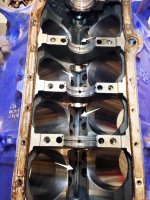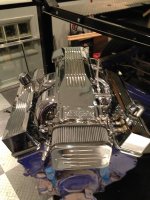bhays
Well-known member
Ok guys. I have my engine totally torn down now and need some advice on components for the next step. I am building the engine for a twin turbo setup so need to stay low compression. This is a street car that might see the track just a time or two, 600hp or so with boost is the goal. The engine was a never fired rebuilt Jasper Performance 325hp and I really only tore into it to replace the rotating assembly with forged (that and to learn). I would love suggestion as to actual rotating assembly kits at Summit, etc.
So here are the specs of the block and components I have on hand (would like to reuse what I can).
Block is bored .040 (not ideal but ok from what I am reading)
Four bolt main
World Products S/R Torquer Heads 1.94 intake, 1.5 exhaust valves
WG-1170 Hydraulic Cam .050 Duration: 224° Intake; 224° Exhaust
Cam Lift: .300 Intake; .307 Exhaust
Valve Lift: .450 Intake; .460 Exhaust
Lobe Center: 114° Intake; 114° Exhaust
Intake is a wide runner tuned port, megasquirt ecm
First question: Should I go with a stroker kit since I am buying a new rotating assembly anyway? I know I don't want to increase compression but would there be benefit of a little more lower end grunt to make it more fun for just driving around not really in boost?
Second question: Can I use my camshaft that I already have, I am on a budget with this build and don't want to just throw money at it that's not necessary. I think I do need to go with roller rockers, however and I haven't been able to determine if I have to switch cams to do that or not.
So what would the experts recommend?
So here are the specs of the block and components I have on hand (would like to reuse what I can).
Block is bored .040 (not ideal but ok from what I am reading)
Four bolt main
World Products S/R Torquer Heads 1.94 intake, 1.5 exhaust valves
WG-1170 Hydraulic Cam .050 Duration: 224° Intake; 224° Exhaust
Cam Lift: .300 Intake; .307 Exhaust
Valve Lift: .450 Intake; .460 Exhaust
Lobe Center: 114° Intake; 114° Exhaust
Intake is a wide runner tuned port, megasquirt ecm
First question: Should I go with a stroker kit since I am buying a new rotating assembly anyway? I know I don't want to increase compression but would there be benefit of a little more lower end grunt to make it more fun for just driving around not really in boost?
Second question: Can I use my camshaft that I already have, I am on a budget with this build and don't want to just throw money at it that's not necessary. I think I do need to go with roller rockers, however and I haven't been able to determine if I have to switch cams to do that or not.
So what would the experts recommend?


